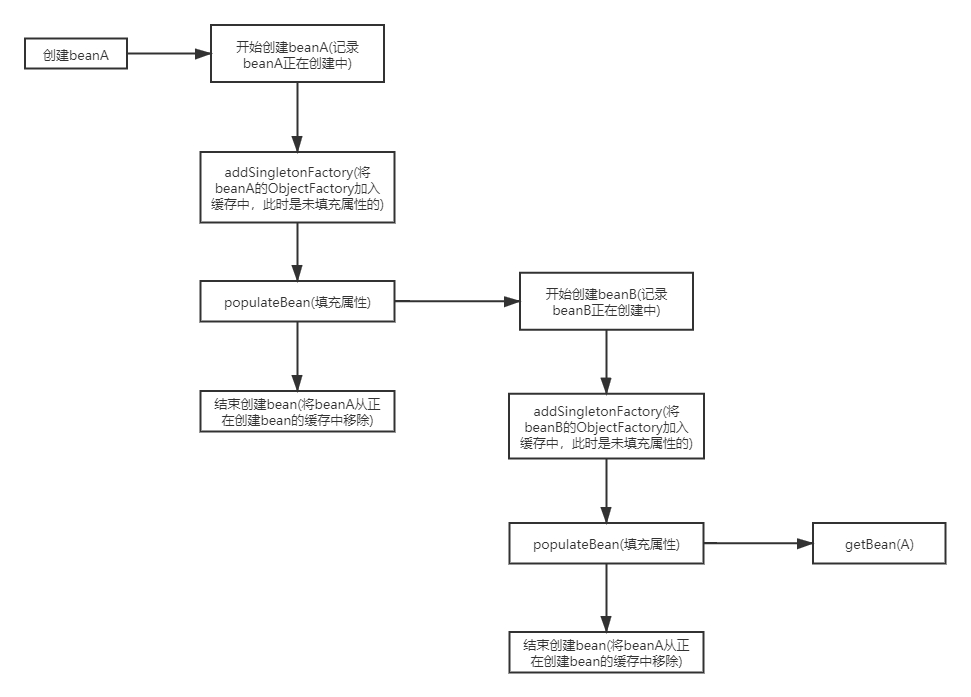Spring IoC 循环依赖的处理
前言
本系列全部基于 Spring 5.2.2.BUILD-SNAPSHOT 版本。因为 Spring 整个体系太过于庞大,所以只会进行关键部分的源码解析。
本篇文章主要介绍 Spring IoC 是怎么解决循环依赖的问题的。
正文
什么是循环依赖
循环依赖就是循环引用,就是两个或多个 bean 相互之间的持有对方,比如A引用B,B引用A,像下面伪代码所示:
public class A {
private B b;
// 省略get和set方法...
}
public class B {
private A a;
// 省略get和set方法...
}
Spring 如何解决循环依赖
Spring IoC 容器对循环依赖的处理有三种情况:
BeanCurrentlylnCreationException setter BeanCurrentlylnCreationException
构造器循环依赖
还是假设上面的A和B类是构造器循环依赖,如下所示:
public class A {
private B b;
public A(B b) {
this.b = b;
}
// 省略get和set方法...
}
public class B {
private A a;
public B(A a) {
this.a = a;
}
// 省略get和set方法...
}
然后我们在 XML 中配置了构造器自动注入,如下:
<?xml version="1.0" encoding="UTF-8"?>
<beans xmlns="http://www.springframework.org/schema/beans"
xmlns:xsi="http://www.w3.org/2001/XMLSchema-instance"
xsi:schemaLocation="http://www.springframework.org/schema/beans http://www.springframework.org/schema/beans/spring-beans.xsd">
<bean id="a" class="com.leisurexi.ioc.circular.reference.A" autowire="constructor" />
<bean id="b" class="com.leisurexi.ioc.circular.reference.B" autowire="constructor" />
</beans>
那么我们在获取 A 时,首先会进入 doGetBean() 方法(该方法在 Spring IoC bean 的加载 中分析过),会进行到如下代码块:
protected <T> T doGetBean(final String name, @Nullable final Class<T> requiredType, @Nullable final Object[] args, boolean typeCheckOnly) throws BeansException {
// 省略其它代码...
// 如果 bean 的作用域是单例
if (mbd.isSingleton()) {
// 创建和注册单例 bean
sharedInstance = getSingleton(beanName, () -> {
try {
// 创建 bean 实例
return createBean(beanName, mbd, args);
}
catch (BeansException ex) {
destroySingleton(beanName);
throw ex;
}
});
// 获取bean实例
bean = getObjectForBeanInstance(sharedInstance, name, beanName, mbd);
}
// 省略其它代码...
}
上面方法中的 getSingleton() 方法会判断是否是第一次创建该 bean ,如果是第一次会先去创建 bean ,也就是调用 ObjectFacoty 的 getObject() 方法,即调用 createBean() 方法创建 bean 前,会先将当前正要创建的 bean 记录在缓存 singletonsCurrentlyInCreation 中。
在创建A时发现依赖 B,便先去创建 B;B在创建时发现依赖A,此时A因为是通过构造函数创建,所以没创建完,便又去创建A,发现A存在于 singletonsCurrentlyInCreation ,即正在创建中,便抛出 BeanCurrentlylnCreationException 异常。
public Object getSingleton(String beanName, ObjectFactory<?> singletonFactory) {
Assert.notNull(beanName, "Bean name must not be null");
// 加锁
synchronized (this.singletonObjects) {
Object singletonObject = this.singletonObjects.get(beanName);
// 一级缓存中不存在当前 bean,也就是当前 bean 第一次创建
if (singletonObject == null) {
// 如果当前正在销毁 singletons,抛出异常
if (this.singletonsCurrentlyInDestruction) {
throw new BeanCreationNotAllowedException(beanName, "Singleton bean creation not allowed while singletons of this factory are in destruction (Do not request a bean from a BeanFactory in a destroy method implementation!)");
}
// 创建单例 bean 之前的回调
beforeSingletonCreation(beanName);
boolean newSingleton = false;
boolean recordSuppressedExceptions = (this.suppressedExceptions == null);
if (recordSuppressedExceptions) {
this.suppressedExceptions = new LinkedHashSet<>();
}
try {
// 获取 bean 实例
singletonObject = singletonFactory.getObject();
newSingleton = true;
}
// 省略异常处理...
finally {
if (recordSuppressedExceptions) {
this.suppressedExceptions = null;
}
// 创建单例 bean 之后的回调
afterSingletonCreation(beanName);
}
if (newSingleton) {
// 将 singletonObject 放入一级缓存,并从二级和三级缓存中移除
addSingleton(beanName, singletonObject);
}
}
// 返回 bean 实例
return singletonObject;
}
}
// 单例 bean 创建前的回调方法,默认实现是将 beanName 加入到当前正在创建 bean 的缓存中,
// 这样便可以对循环依赖进行检测
protected void beforeSingletonCreation(String beanName) {
if (!this.inCreationCheckExclusions.contains(beanName) && !this.singletonsCurrentlyInCreation.add(beanName)) {
throw new BeanCurrentlyInCreationException(beanName);
}
}
// 单例 bean 创建后的回调方法,默认实现是将 beanName 从当前正在创建 bean 的缓存中移除
protected void afterSingletonCreation(String beanName) {
if (!this.inCreationCheckExclusions.contains(beanName) && !this.singletonsCurrentlyInCreation.remove(beanName)) {
throw new IllegalStateException("Singleton '" + beanName + "' isn't currently in creation");
}
}
protected void addSingleton(String beanName, Object singletonObject) {
synchronized (this.singletonObjects) {
// 这边bean已经初始化完成了,放入一级缓存
this.singletonObjects.put(beanName, singletonObject);
// 移除三级缓存
this.singletonFactories.remove(beanName);
// 移除二级缓存
this.earlySingletonObjects.remove(beanName);
// 将 beanName 添加到已注册 bean 缓存中
this.registeredSingletons.add(beanName);
}
}
setter循环依赖
还是假设上面的A和B类是 field 属性依赖注入循环依赖,如下所示:
public class A {
private B b;
// 省略get和set方法...
}
public class B {
private A a;
// 省略get和set方法...
}
然后我们在 XML 中配置了按照类型自动注入,如下:
<?xml version="1.0" encoding="UTF-8"?>
<beans xmlns="http://www.springframework.org/schema/beans"
xmlns:xsi="http://www.w3.org/2001/XMLSchema-instance"
xsi:schemaLocation="http://www.springframework.org/schema/beans http://www.springframework.org/schema/beans/spring-beans.xsd">
<bean id="a" class="com.leisurexi.ioc.circular.reference.A" autowire="byType" />
<bean id="b" class="com.leisurexi.ioc.circular.reference.B" autowire="byType" />
</beans>
Spring 在解决单例循环依赖时引入了三级缓存,如下所示:
// 一级缓存,存储已经初始化完成的bean private final Map<String, Object> singletonObjects = new ConcurrentHashMap<>(256); // 二级缓存,存储已经实例化完成的bean private final Map<String, Object> earlySingletonObjects = new HashMap<>(16); // 三级缓存,存储创建bean实例的ObjectFactory private final Map<String, ObjectFactory<?>> singletonFactories = new HashMap<>(16); // 按先后顺序记录已经注册的单例bean private final Set<String> registeredSingletons = new LinkedHashSet<>(256);
首先在创建A时,会进入到 doCreateBean() 方法(前面的流程可以查看 Spring IoC bean 的创建 一文),如下:
protected Object doCreateBean(final String beanName, final RootBeanDefinition mbd, final @Nullable Object[] args) throws BeanCreationException {
// 获取bean的实例
BeanWrapper instanceWrapper = null;
if (instanceWrapper == null) {
// 通过构造函数反射创建bean的实例,但是属性并未赋值
instanceWrapper = createBeanInstance(beanName, mbd, args);
}
// 获取bean的实例
final Object bean = instanceWrapper.getWrappedInstance();
// 省略其它代码...
// bean的作用域是单例 && 允许循环引用 && 当前bean正在创建中
boolean earlySingletonExposure = (mbd.isSingleton() && this.allowCircularReferences && isSingletonCurrentlyInCreation(beanName));
// 如果允许bean提前曝光
if (earlySingletonExposure) {
// 将beanName和ObjectFactory形成的key-value对放入singletonFactories缓存中
addSingletonFactory(beanName, () -> getEarlyBeanReference(beanName, mbd, bean));
}
// 省略其它代码...
}
在调用 addSingletonFactory() 方法前A的实例已经创建出来了,只是还未进行属性赋值和初始化阶段,接下来将它放入了三级缓存中,如下:
protected void addSingletonFactory(String beanName, ObjectFactory<?> singletonFactory) {
Assert.notNull(singletonFactory, "Singleton factory must not be null");
// 加锁
synchronized (this.singletonObjects) {
// 如果一级缓存中不包含当前bean
if (!this.singletonObjects.containsKey(beanName)) {
// 将ObjectFactory放入三级缓存
this.singletonFactories.put(beanName, singletonFactory);
// 从二级缓存中移除
this.earlySingletonObjects.remove(beanName);
// 将beanName加入到已经注册过的单例bean缓存中
this.registeredSingletons.add(beanName);
}
}
}
接下来A进行属性赋值阶段(会在后续文章中单独分析这个阶段),发现依赖B,便去获取B,发现B还没有被创建,所以走创建流程;在B进入属性赋值阶段时发现依赖A,就去调用 getBean() 方法获取A,此时会进入 getSingleton() 方法(该方法的调用流程在 Spring IoC bean 的加载 一文中分析过),如下:
public Object getSingleton(String beanName) {
// allowEarlyReference设置为true表示允许早期依赖
return getSingleton(beanName, true);
}
protected Object getSingleton(String beanName, boolean allowEarlyReference) {
// 先从一级缓存中,检查单例缓存是否存在
Object singletonObject = this.singletonObjects.get(beanName);
// 如果为空,并且当前bean正在创建中,锁定全局变量进行处理
if (singletonObject == null && isSingletonCurrentlyInCreation(beanName)) {
synchronized (this.singletonObjects) {
// 从二级缓存中获取
singletonObject = this.earlySingletonObjects.get(beanName);
// 二级缓存为空 && bean允许提前曝光
if (singletonObject == null && allowEarlyReference) {
// 从三级缓存中获取bean对应的ObjectFactory
ObjectFactory<?> singletonFactory = this.singletonFactories.get(beanName);
if (singletonFactory != null) {
// 调用预先设定的getObject(),获取bean实例
singletonObject = singletonFactory.getObject();
// 放入到二级缓存中,并从三级缓存中删除
// 这时bean已经实例化完但还未初始化完
// 在该bean未初始化完时如果有别的bean引用该bean,可以直接从二级缓存中取出返回
this.earlySingletonObjects.put(beanName, singletonObject);
this.singletonFactories.remove(beanName);
}
}
}
}
return singletonObject;
}
尝试一级缓存 singletonObjects (肯定没有,因为A还没初始化完全),尝试二级缓存 earlySingletonObjects (也没有),尝试三级缓存 singletonFactories ,由于A通过 ObjectFactory 将自己提前曝光了,所以B能够通过 ObjectFactory.getObject() 拿到A对象(虽然A还没有初始化完全,但是总比没有好呀)。B拿到A后顺利创建并初始化完成,调用上面分析过的 addSingleton() 方法将自己放入一级缓存中。此时返回A中,A也能顺利拿到完全初始化的B进行后续的阶段,最后也将自己放入一级缓存中,并从二级和三级缓存中移除。
过程图如下所示:

非单例循环依赖
对于非单例的 bean ,Spring 容器无法完成依赖注入,因为 Spring 容器不进行缓存,因此无法提前暴露一个创建中的 bean 。
总结
本文主要介绍了 Spring 对三种循环依赖的处理,其实还有一种字段循环依赖,比如 @Autowired 注解标注的字段,但它和 setter 循环依赖的解决方法一样,这里就没有多说。
最后,我模仿 Spring 写了一个精简版,代码会持续更新。地址: https://github.com/leisurexi/tiny-spring 。
参考
- 《Spring 源码深度解析》—— 郝佳
- https://juejin.im/post/5c98a7b4f265da60ee12e9b2
- 本文标签: 一级缓存 struct CTO 锁 文章 HashMap map 实例 schema 二级缓存 HashSet 代码 解决方法 删除 id cat 解析 spring ioc ioc 源码 缓存 GitHub value http MQ https HTML 总结 bean root synchronized UI key src IO git App final BeanDefinition spring ConcurrentHashMap 配置 XML build
- 版权声明: 本文为互联网转载文章,出处已在文章中说明(部分除外)。如果侵权,请联系本站长删除,谢谢。
- 本文海报: 生成海报一 生成海报二










![[HBLOG]公众号](https://www.liuhaihua.cn/img/qrcode_gzh.jpg)

